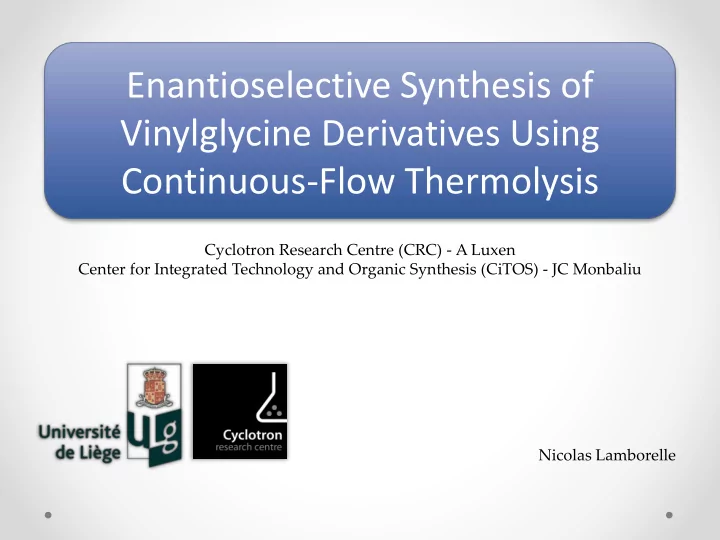

Enantioselective Synthesis of Vinylglycine Derivatives Using Continuous-Flow Thermolysis Cyclotron Research Centre (CRC) - A Luxen Center for Integrated Technology and Organic Synthesis (CiTOS) - JC Monbaliu Nicolas Lamborelle
1. Introduction • Most straightforward synthesis: • Vgl is an interesting building block 1
2. Background • Thermolysis step and side-products: ∆ • Previously described methods: Conventional reflux: Kugelrohr apparatus: Universal glassware High ee Long reaction time at high T Low amount of DHB T limited by solvent No solvent Unusual solvents Low yields High quantities of DHB Poor reproducibility (difficult to Low ee control vacuum and T) Not scalable 2
3. Finding a solution • Flow chemistry (CHIM9265-1 ) Pressure control Temperature not limited by the solvent Usual solvents Accurate control of residence time & reaction conditions As soon as Vgl is formed, it is no longer exposed to high T Larger scale accessible through numbering-up Promote formation of Vgl (kinetic product) over DHB (thermodynamic product). • Side product formation (DHB + racemization) Rationalization by computational studies 3
4. Computational studies computational studies were performed at the B3LYP/6-31+G* level of theory 4
4. Computational studies computational studies were performed at the B3LYP/6-31+G* level of theory 4
4. Computational studies computational studies were performed at the B3LYP/6-31+G* level of theory 4
5. Mesofluidic device Liquid toluene @ 250-290 °C (bp. 110 °C under STP) Stainless steal L = 6 m Ø ext = 1/16’’ Ø int = 500 µm for optimal heat exchange 5
5. Experimental results 100 80 60 40 20 0 1 3 5 1 3 5 1 3 5 1 3 5 1 3 5 1 3 5 1 3 5 1 3 5 1 3 5 mL.min -1 0.0 0.2 1.0 0.0 0.2 1.0 0.0 0.2 1.0 eq. of scavenger 250 °C 270 °C 290 °C 6
5. Experimental results 100 80 60 40 20 0 1 3 5 1 3 5 1 3 5 1 3 5 1 3 5 1 3 5 1 3 5 1 3 5 1 3 5 mL.min -1 0.0 0.2 1.0 0.0 0.2 1.0 0.0 0.2 1.0 eq. of scavenger 250 °C 270 °C 290 °C 6
5. Experimental results 100 80 60 40 20 0 1 3 5 1 3 5 1 3 5 1 3 5 1 3 5 1 3 5 1 3 5 1 3 5 1 3 5 mL.min -1 0.0 0.2 1.0 0.0 0.2 1.0 0.0 0.2 1.0 eq. of scavenger 250 °C 270 °C 290 °C 6
5. Experimental results MetO (%) Vgl (%) DHB (%) CBzNH-MetO-OMe 1.2 98.8 0 BocNH-MetO-OMe / / / FmocNH-MetO-OMe 1.6 98.4 0 NBOCNH-MetO-OMe 2.4 97.6 0 CbzNH-MetO-OBn 1.5 98.5 0 BocNH-MetO-OBn / / / FmocNH-MetO-OBn 2.1 97.9 0 NBOCNH-MetO-OBn 3.3 96.7 0 7
6. Conclusion • We designed and build a mesofluidic device capable of producing 11.5 g.day -1 (190 USD/g) of CbzNH-Vgl-OMe with high yields (~99%) and ee (>95%) . • Best conditions also work for a variety of protecting groups . • Contrary to batch methods, production can be continuously monitored and tune if necessary. • Great reproducibility • Production could be raised simply by numbering up . 8
Thanks for your attention
Recommend
More recommend